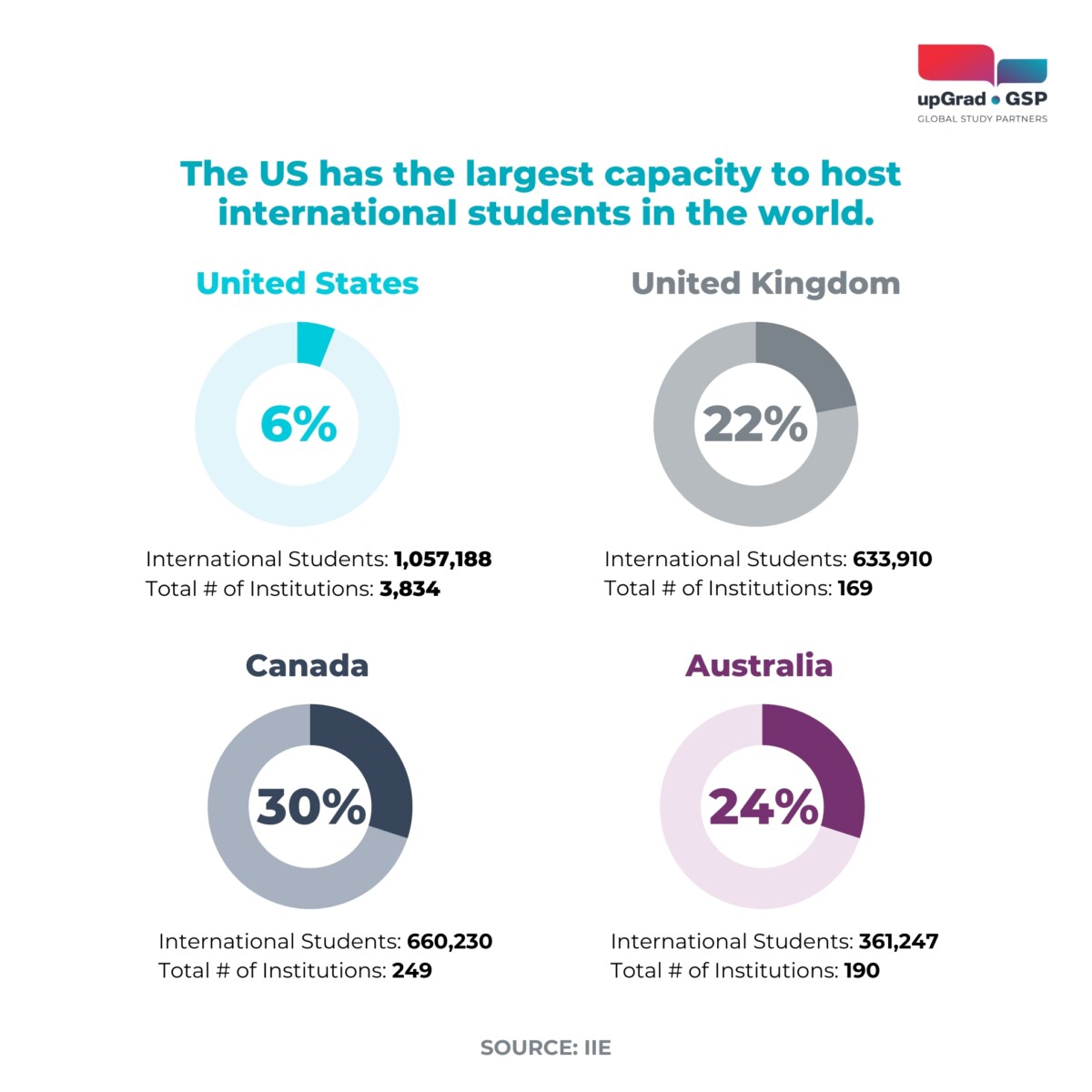International student numbers in the United States have seen significant growth over the past few decades. From just 144,708 international students in the 1970-1971 academic year, these numbers have spiked to 1,057,188 in the 2022-2023 academic year, according to the Open Doors® Report on International Educational Exchange. This growth has increased by 4% in 2020-2021 and a 12% increase in 2022-2023, and forecasts anticipate an 8% growth in the 2023-2024 academic year.

Furthermore, projections indicate a rise from six million international student enrolments in 2023 to over 10 million in the next six years. The consistent rise highlights the U.S. as one of the leading destinations for international students. The country’s ability to attract students from different countries is rooted in the quality of educational institutions, the availability of cutting-edge research and opportunities, and the cultural richness and openness that international students bring to campuses. Moreover, the decentralised nature of U.S. higher education, with numerous accredited institutions across states, cities and local communities, offers a wide array of options for students with different academic interests and financial capabilities.
To address the projected increase in international students, the U.S. Departments of State and Education have issued a Joint Statement of Principles in Support of International Education, underlining the importance of international students and incorporating international education into the U.S. Export Strategy.
Furthermore, U.S. institutions are also diversifying their recruitment efforts beyond traditional markets such as China and India. They are targeting emerging markets like Vietnam, Nigeria, Brazil, and others that have shown strong connections to U.S. higher education and this has broadened recruitment horizons and ensures a more varied and resilient international student body.
By prioritising internationalisation, integrating it into their diversity strategies, expanding support services and advocating for streamlined visa processes, U.S. higher education institutions are well-prepared to handle the anticipated increase in international students.
Key trends in academic mobility in the US
The landscape of academic mobility in the United States is experiencing dynamic changes, driven by increasing international student interest and evolving global education demands. As the U.S. continues to be a top choice for students worldwide, understanding these trends is crucial for shaping policies and strategies that enhance international students’ educational experience and economic contributions. Here are the key trends shaping academic mobility in the U.S.:
Increasing international student population
International students in the U.S. come from over 210 countries, making the student body highly diverse. The top two places of origin are China and India, accounting for 52% of all international students.
Following the COVID-19 pandemic, many countries have seen a rebound in the number of students studying in the U.S with Bangladesh, Colombia, Ghana, India, Italy, Nepal, Pakistan and Spain reaching all-time highs.
High demand for international students
There is a strong demand for international students in the U.S. With domestic enrolment projecting a 15% decline, international students are seen as a critical component to maintaining student numbers. U.S. colleges and universities are eager to expand their international student populations, with 92% of institutions expressing a desire to boost these numbers and 85% maintaining or increasing financial support for international recruitment. Projections indicate that U.S. institutions could enrol up to 2 million international students by 2030, with emerging markets such as Bangladesh, Brazil, Ghana, India and Mexico showing potential for significant growth.
Contribution of international students to the US economy
International students contribute to the U.S. economy, bringing over $40 billion in the 2022-2023 academic year and supporting over 368,000 jobs. The majority of their funding comes from personal resources, adding to the U.S. economy’s promising growth. Additionally, the Optional Practical Training (OPT) program also allows international students to gain practical experience post-graduation, further contributing to sectors like arts, industry, science, and healthcare.
International enrolment growth forecast by 2030
Forecasts for 2030 suggest three potential scenarios for international student enrollment in the U.S. Under robust growth, the U.S. could see up to 2 million students with an average annual growth rate of 8-10%. Steady growth predicts 1.7 million students with 5-7% annual growth, while slowed growth anticipates 1.3 million students with a 2-3% growth rate. The largest increases are expected from regions with expanding tertiary-age populations and insufficient local higher education capacity.
Prioritising growth and support for international students
The U.S. government and educational institutions are taking proactive steps to support and grow international student enrollment. Key initiatives include the Joint Statement of Principles in Support of International Education, increased visa issuances, and extensive advising services through the EducationUSA Network. U.S. colleges and universities are also ramping up their recruitment efforts and collaborating with international organisations to promote the benefits of studying in the U.S.
Recommendations for success
To further ensure success in attracting and retaining international students, the report recommends the following steps:
- prioritise internationalisation at the highest levels of their strategy
- incorporate internationalisation into their diversity efforts
- expand housing and support services to accommodate growing numbers.
- broaden recruitment efforts beyond traditional markets like China and India
- provide financial support options to attract cost-conscious students
- advocate for increased student visa issuances and support from the U.S. Consular Services.
By focusing on these strategies, U.S. colleges and universities can ensure a thriving and diverse international student population well into the future.
To know more about the opportunities available for international students and updates about education in the USA, check out our blog or reach out to our North American team at gspna@globalstudypartners.com.
To view the full report, check out the Outlook 2030 Brief, The US. and International Education report from IIE.




